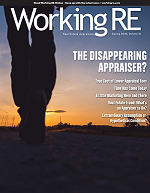 |
> How to Support and Prove Your Adjustments (7 Hours CE) (Highest Rating!) |
Extraordinary Assumption or Hypothetical Condition?
By Phil Spool, ASA
Every now and then, I come across an appraisal report where the appraiser is confused about whether the appraisal requires an extraordinary assumption or a hypothetical condition. One appraiser even went as far as to erroneously describe the situation as being a “hypothetical assumption,” with another calling it an “extraordinary condition.” What?
Some situations are complicated and I can understand the confusion. Others should be simple to understand. This article will hopefully help you understand the basic difference between an extraordinary assumption and a hypothetical condition.
While the Uniform Standards of Professional Appraisal Practice (USPAP) does not require you to label your situation as either an extraordinary assumption or a hypothetical condition, USPAP states in Standards Rule 2-1 (c) that each written or oral real property appraisal report must “clearly and accurately disclose all assumptions, extraordinary assumptions, hypothetical conditions, and limiting conditions used in the assignment.” Therefore, you must disclose all extraordinary assumptions and limiting conditions.
Extraordinary Assumption
The Uniform Standards of Professional Appraisal Practice (USPAP) defines an extraordinary assumption as: “An assumption, directly related to a specific assignment, as of the effective date of the appraisal results, which, if found to be false, could alter the appraiser’s opinions or conclusions.” In essence, an extraordinary assumption is what you assume to exist. Extraordinary assumptions can be based on a number of factors or conditions, including:
(a) Not being able to gain access to a bedroom or other area. This can leave doubt as to the size or physical condition of that particular room or rooms. Why was that area not available for you to observe? One appraiser I know was told by the homeowner that the bedroom was occupied by his daughter who had chickenpox. The appraiser was not allowed to even open the door of the bedroom to see its condition. Another appraiser could not gain access to a bedroom as the teenage child had a lock on his door and wouldn’t permit his parents to gain access. It turns out that the bedroom with the chickenpox child had physical issues and the appraiser did not question the homeowner and did not mention in his report that access was not made. The appraiser was then sued by the buyer of the house.
Therefore, the appraiser should make the extraordinary assumption that the condition of the room(s) or area(s) not observed is similar to the other bedrooms or other areas of the building being appraised. This also applies when appraising a multi-tenant building, such as an apartment complex, shopping center, office building or warehouse.
(b) The subject’s unobserved physical condition. In addition to the situation described above, the appraiser should also be observant of the areas outside of the building but still on the subject’s site. If you notice that there are a number of deferred maintenance items (items that need repairing or replacing), then you need to mention this in your appraisal report and be as specific as possible. An extraordinary assumption might refer to the areas you did not observe, making an assumption that they are similar to the areas you did observe. Also, if there are any additional unforseen deferred maintenance items that you did not observe, you can make the extraordinary assumption that any additional unforseen deferred maintenance items may have an effect on the value of the property. This would be a good time to suggest that a general contractor or home inspector be hired and arrive at an appropriate cost to cure.
(story continues below)

(story continues)
(c) The physical condition of unobserved comparable sales. I have seen only a few appraisal reports where the appraiser makes the extraordinary assumption that the comparable sale’s Multiple Listing Service remarks about the property, the MLS photographs (interior and exterior) and the verification of the physical condition (renovations, etc.) by the real estate agent are deemed to be true and correct. Other appraisers make the extraordinary assumption that the information supplied to the appraiser from verified sources is deemed to be reliable and correct. By making this extraordinary assumption, you are stating to your client that you made your best effort regarding the information obtained about your comparable sales and assumed that the information you obtained was reliable.
(d) Regarding deferred maintenance and the estimated cost to cure, an appraiser can make the extraordinary assumption that the cost to cure the subject’s deferred maintenance is based on reliable sources and if not, then any change may have an effect on the final value determined.
(e) Regarding a “retrospective” market value, the appraiser makes the extraordinary assumption that the physical condition of the subject as of the date of value (value date in the past) is similar to the date of observation (date you went out to the property). This assumption needs to be confirmed with the property owner or owner’s representative at the time of the visit.
(story continues below)
(story continues)
Hypothetical Condition
The Uniform Standards of Professional Appraisal Practice (USPAP) defines a hypothetical condition as: “A condition, directly related to a specific assignment, which is contrary to what is known by the appraiser to exist on the effective date of the assignment results, but is used for the purpose of analysis.” In essence, a Hypothetical Condition is something contrary to what exists as of the effective date of value.
Hypothetical Conditions could be based on a number of factors or conditions, including:
(a) Appraising a proposed property (such as a house) while the property is currently a vacant lot. In this case, you will be making a hypothetical condition that the non-existent improvements actually exist as of a current date and not the expected completion date, which is referred to as a prospective date. When appraising a proposed house for lending purposes, the Fannie Mae Form 1004 states that you are using the hypothetical condition that the subject improvements are completed as of the effective (current) date of appraisal. The hypothetical condition is that the improvements do not exist or are under construction and your valuation is based on the completion of the improvements.
(b) Valuing the property “subject to curing the deferred maintenance.” The improvements have deferred maintenance that you personally observed and there may be unseen deferred maintenance that you did not observe. Perhaps the cost to cure is something you don’t feel comfortable estimating as it is beyond your expertise. If you decide to value the property “subject to curing the deferred maintenance,” then it becomes a hypothetical condition as your value is contrary to what exists. This is different than deducting the estimated deferred maintenance to arrive at the “as is” market value of the subject, In that case, you would be making an extraordinary assumption that the estimated cost to cure the subject’s deferred maintenance is based on reliable sources and if not, then any change may have an effect on the final value determined. In other words, determining the “as is” market value, and deducting the deferred maintenance, requires an extraordinary assumption, while determining the value “subject to” is a hypothetical condition.
(c) An addition was added illegally and you are requested to value the property as if it didn’t exist. This is considered a hypothetical condition as it is “contrary to what exists.” I had an appraisal assignment where the addition was made over a canal maintenance easement. The survey was a barely readable copy. The title company and lender did not pay attention to the existing easement until the property went into foreclosure. My assignment was to value the property without the existing canal maintenance easement. The value that excludes the existing easement reflected a hypothetical condition (contrary to what existed).
(d) Valuing a property with a different zoning than it currently has, providing that the alternate zoning is a feasible choice. A prime example would be valuing a single family residence zoned for residential use along a busy street while single family residences across the same street, with commercial zoning, were converted into commercial usage, such as a dentist office or an insurance agency. If it appears feasible that the residential zoning can be converted into commercial zoning, then the appraisal of the subject single family residence as a commercial usage would require a hypothetical condition. In conclusion, each extraordinary assumption and hypothetical condition should be included in the General Assumptions and Limiting Conditions section of the appraisal report. Most importantly, the extraordinary assumption and/or hypothetical condition must be reasonable and supportable in the context of the appraisal assignment that results in a credible opinion of value.
Valuable CE Offered Online – 7 Hours
How To Support and Prove Your Adjustments
Presented by: Richard Hagar, SRA
Do you have the proper support for your adjustments? Stop taking the same old CE courses and learn proven adjustment methods with instructor Richard Hagar, SRA. Fannie Mae states that the number one reason appraisals are flagged is the “use of adjustments that do not reflect market reaction.” Stay out of trouble with Fannie Mae, your state board and your AMC/lender clients with solid, supportable adjustments. Up your game, avoid time-consuming callbacks and earn approved CE today!
“Why wasn’t this taught years ago?” – Jackie Henry
How to Support and Prove Your Adjustments
Sign Up Now! $119 – 7 Hrs. Approved CE
(OREP Member Price: $99)
About the Author
Philip G. Spool, ASA, is a State-Certified General Real Estate Appraiser in Florida, appraising since 1973. Formerly the Chief Appraiser of Flagler Federal Savings and Loan Association, he has been self-employed for the past 20 years. In addition to appraising, he is an instructor with Miami Dade College, teaching appraisal courses and continuing education. He is also the Vice President and Chairman of real estate programs with the Greater Miami Chapter of the American Society of Appraisers. He can be reached at pgspool@bellsouth.net.
Send your story submission/idea to the Editor: isaac@orep.org




by Suzanne McIlrath
Thank you so much for this article. I have some work to do now updating my skeletons/outline appraisals. And, Mr. Gillespie is so right…to be an appraiser is a lifetime of learning and adapting to changes. Personally, I love that aspect about this career. I know this article was written long ago but it is still very valid today.
-by George Koury
When using a hypothetical condition to value a property and, of course, clearly stating all contributing factors, may the report be completed “as-is” or must it be completed “subject to”?
-by Edd Gillespie
How odd that a well written article about a substantive appraisal issue that many appraisers have little understanding of has only the one comment from me.
Maybe Mr. Spool answered every question any appraiser may have or my experience is 180 out and most appraisers have a good grasp of the use of these terms and use them when needed and correctly.
Yeah, right!
-by Edd Gillespie
Thanks Mr. Spool, This, among your other contributions, should be printed and pasted to the foreheads of every appraiser until they learn what you are teaching them.
I too have encountered much confusion on the part of appraisers about these distinctions. I have no idea who believed it was necessary to attach the adjective extraordinary since almost any assumption I can think of if found to be untrue will have some impact on value (er, probable price) opinions. Senior designated appraisers are not immune from the confusion. To add to the mess, the next USPAP cycle will change “extraordinary” to “special.” As might be expected, many of those who don’t understand also refuse to make an effort to understand and belittle the requirements to use either.
No wonder Fannie guidelines and clients strictly limit the use of both. But then 1004 appraisers just forget to follow USPAP even when the assignment clearly requires one or the other or both be employed and mentioned prominently in the report.
Can you come up with an article about the need to embrace an attitude of life-long learning if one aspires to appraise? No doubt you need to brace yourself for a personal attack if you do.
Thanks for the well written and cogent article.
-